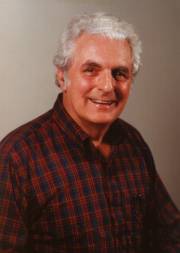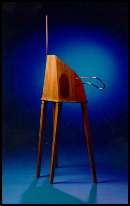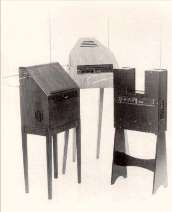INTERVIEW
WITH ROBERT
MOOG
Conducted by Jorge Munnshe for Amazing Sounds (1998)
By the mid sixties, in the USA, Robert
Moog,
an electronic engineer who had a musical background, built the first
voltage-controlled
synthesizer. At once he awoke the interest of the scientific community
with this. As well
as that of the musical community.
 It did not take long for
Moog
to get orders from musicians who felt the need to do new things. He
built costumized units
for each one of them. Some of his first customers were Wendy
Carlos, Eric Siday,
and Keith Emerson. Carlos utilized
the synthesizer to
perform in a masterly way the Brandenbourg Concerts by J.S.
Bach,
thus proving that electronic instruments were no worthless gizmos to
produce sonic special
effects for rays shot by Martian invaders, but they could really be
musical instruments of
their own right, with a warmth and an expressiveness capable of
competing with those
typical of acoustic instruments. Siday recorded with
the synthesizer
musical pieces for advertisements, thus taking the first step towards
the nowadays widely
trodden path of electronic music for television. Emerson
utilized for the
first time the synthesizer at a live performance, thus proving that it
was not a
laboratory machine, but an instrument with all its qualities, which
allowed for live
performances to take place.
It did not take long for
Moog
to get orders from musicians who felt the need to do new things. He
built costumized units
for each one of them. Some of his first customers were Wendy
Carlos, Eric Siday,
and Keith Emerson. Carlos utilized
the synthesizer to
perform in a masterly way the Brandenbourg Concerts by J.S.
Bach,
thus proving that electronic instruments were no worthless gizmos to
produce sonic special
effects for rays shot by Martian invaders, but they could really be
musical instruments of
their own right, with a warmth and an expressiveness capable of
competing with those
typical of acoustic instruments. Siday recorded with
the synthesizer
musical pieces for advertisements, thus taking the first step towards
the nowadays widely
trodden path of electronic music for television. Emerson
utilized for the
first time the synthesizer at a live performance, thus proving that it
was not a
laboratory machine, but an instrument with all its qualities, which
allowed for live
performances to take place.
What are you currently working on? Can you tell us
about your recent
activities and your projects for the near future?
"Big Briar's latest development is our Ethervox MIDI Theremin. We're
starting to
make and ship them now, but we still have a lot of work to do by way of
taking care of the
many final engineering details".
"Our next big project is to design a new version of the classic
Minimoog. We will
be introducing this instrument next summer. It will have all the great
sound and function
of the classic Minimoog Model D (the instrument that my old company
made from 1970 to
1982), plus a few new features that musicians have been asking for.
This new instrument of
ours will have the MOOG trademark".
 Is the collaboration with musicians a
good help to
direct your research towards the best way? Were the opinions of
musicians about your first
synthesizers useful when you were developing them?
Is the collaboration with musicians a
good help to
direct your research towards the best way? Were the opinions of
musicians about your first
synthesizers useful when you were developing them?
"I've been collaborating with musicians since I first began
designing synthesizers
in 1964. Every good idea of ours has come about through the
collaboration with musicians.
When we were first developing synthesizer modules during the mid
sixties, musicians were
always giving us good ideas for improvements, and we always listened to
them".
Out of the music industry, have you worked in other
technology fields?
"Except for a couple of summer jobs in the mainstream electronics
industry, I have
spent my entire working life designing and building electronic musical
instruments".
What do you think of the competition between
analogical versus digital
synthesizers?
"Well, there are some things that digital synthesizers can do better
than analog,
and there are some things that analog can do better than digital. It's
possible to make a
digital model of an "ideal" analog circuit, but it still sounds
digital, because
there is none of the characteristic analog warmth and richness of sound
that comes from
the little technical variations and imperfections of analog circuits.
Digital instruments
are fine for a lot of things, like sample playback, programmability,
precision, and
relatively low price. But soundwise, I think we're talking about the
difference between,
say, a plastic guitar and a wood guitar".
Can you tell us some funny anecdote in the history
of Moog synthesizers
and your contact with the musicians playing them that you remember in a
special way?
"I remember the first time we showed our modular MOOG synthesizers
out on the West
Coast. It was 1967, the year before Switched-on Bach was
released. We had sold a
few modular systems to East Coast commercial musicians, but the Los
Angeles music scene
didn't know about us at all. We showed up at the 1967 Audio Engineering
Society convention
in Los Angeles with a large modular synthesizer. The musicians who saw
our exhibit the
first day went home and told all their friends, and the next two or
three days were
incredibly busy, and we wound up selling several synthesizers that were
later used in all
sorts of Hollywood films and West Coast pop and commercial music".
"One evening during that AES Convention, my friend Paul
Beaver,
who was an electronic instrument guru in LA at that time, took our
modular system out of
our exhibit and into a recording studio where they were laying down
tracks for an Elektra
album called Zodiac Cosmic Sounds. Paul
recorded a few good fat
analog sounds for the album. One of those sounds was used as the very
first sound on the
album. As far as I know, that's the first use of a Moog modular
synthesizer on a West
Coast pop record".
 How did you decide to make theremins when
you were
around 16 year old?
How did you decide to make theremins when
you were
around 16 year old?
"When I was in my early teens, building simple novelty electronic
musical
instruments was a hobby of mine. In 1949 I saw an article on how to
build a theremin in
the hobby magazine Radio and TV News. I built my first
theremin from the
instructions in that article. I was 15 at the time".
Has Leon Theremin (Lev Termen) been a big influence
for your musical
technology career? Can you tell us about your relation with him &
his collaborators?
"I knew very little about Theremin when I first
started.
Remember, the Cold War between the United States and the Soviet Union
was going full blast
back then, and it was extremely difficult for anybody in this country
to get information
on people like Theremin. Little by little I learned
about Theremin.
At one point during the fifties, I got a schematic diagram of the
"original" RCA
theremin, and studied it carefully. That was the beginning of my real
understanding of
what a genius Theremin was".
"I met Clara Rockmore first during the early
sixties, and then I
became good friends with her and her family during the seventies. Clara
was a protegee of Theremin, and a very close friend
of his during the
thirties, so I learned a lot about Theremin from Clara".
"I finally met Theremin in Bourges, France, in
1989, and again in
this country in 1992. By then the cold war was over, so it was possible
for Theremin
to re-establish contact with his friends and colleagues in the West. By
the time I met
him, I knew a good deal about what he had done, and what an influence
he had been on the
development of electronic musical instrument technology".
 How did you decide to make theremins
after your
work making Moog synthesizers?
How did you decide to make theremins
after your
work making Moog synthesizers?
"I never really stopped making theremins. I made them for sale from
1954 on. After
1964, my company was very busy making synthesizers, and the general
public forgot about
the theremin for a while, so I made very few theremins between 1965 and
1978. From 1978 to
maybe 1990, there was very little interest in the theremin, but I did
make a few theremins
to order. In 1991 interest in the theremin seemed to pick up, so I came
up with a new
design, the Big Briar Series 91 theremins. In 1996 I published a
do-it-yourself theremin
article for Electronic Musician magazine, and this became the
basis for our
popular Etherwave theremin".
Do you think that your work making synthesizers
& new theremin
models is not only a technological activity, but an artistic one also?
"It's certainly more than a technological activity, although we
instrument
designers certainly use electronic technology as a design tool. But I
wouldn't call it an
artistic activity. We're toolmakers. Making tools is a craft, maybe
even a high craft. I'd
say that we are craftsmen rather than artists".
Have you been a professional musician? Have you
composed some music?
How do you think your life might be if you were chosen to work as a
musician rather than
an electronic instruments inventor?
"I've studied music, primarily as a child, because my mother wanted
me to. And I
played piano in a four-piece dance band during the fifties. We were
pretty bad. I really
don't think I could have made a living as a musician. It's not in me.
Designing electronic
stuff is my calling".
Would you like to add something else?
"I want the general public to know that I have applied to the United
States
Trademark office to get the MOOG tradename back. There is a little
confusion now because
one or two other people are also using my name as a trademark on
electronic musical
instruments. My position is that these people are doing so without my
permission and are
therefore violating my exclusive right to use my name as a trademark.
We are opposing all
uses of the MOOG name as a trademark, except on instruments made by me
or by my company,
Big Briar. Visit Big Briar's website for up-to-date information in the
MOOG
trademark".
"My email address is realmoog@bigbriar.com.
Our website is: http://www.bigbriar.com".
"Anybody who is interested in MOOG synthesizers, or Big Briar
theremins is invited
to visit the Big Briar website, or to correspond with me directly by
email. I can't
promise that I'll answer every email, but I'll do my best".
Thank you very much!
 Previous Page
(Articles/News)
Previous Page
(Articles/News)
 It did not take long for
Moog
to get orders from musicians who felt the need to do new things. He
built costumized units
for each one of them. Some of his first customers were Wendy
Carlos, Eric Siday,
and Keith Emerson. Carlos utilized
the synthesizer to
perform in a masterly way the Brandenbourg Concerts by J.S.
Bach,
thus proving that electronic instruments were no worthless gizmos to
produce sonic special
effects for rays shot by Martian invaders, but they could really be
musical instruments of
their own right, with a warmth and an expressiveness capable of
competing with those
typical of acoustic instruments. Siday recorded with
the synthesizer
musical pieces for advertisements, thus taking the first step towards
the nowadays widely
trodden path of electronic music for television. Emerson
utilized for the
first time the synthesizer at a live performance, thus proving that it
was not a
laboratory machine, but an instrument with all its qualities, which
allowed for live
performances to take place.
It did not take long for
Moog
to get orders from musicians who felt the need to do new things. He
built costumized units
for each one of them. Some of his first customers were Wendy
Carlos, Eric Siday,
and Keith Emerson. Carlos utilized
the synthesizer to
perform in a masterly way the Brandenbourg Concerts by J.S.
Bach,
thus proving that electronic instruments were no worthless gizmos to
produce sonic special
effects for rays shot by Martian invaders, but they could really be
musical instruments of
their own right, with a warmth and an expressiveness capable of
competing with those
typical of acoustic instruments. Siday recorded with
the synthesizer
musical pieces for advertisements, thus taking the first step towards
the nowadays widely
trodden path of electronic music for television. Emerson
utilized for the
first time the synthesizer at a live performance, thus proving that it
was not a
laboratory machine, but an instrument with all its qualities, which
allowed for live
performances to take place. Is the collaboration with musicians a
good help to
direct your research towards the best way? Were the opinions of
musicians about your first
synthesizers useful when you were developing them?
Is the collaboration with musicians a
good help to
direct your research towards the best way? Were the opinions of
musicians about your first
synthesizers useful when you were developing them? How did you decide to make theremins when
you were
around 16 year old?
How did you decide to make theremins when
you were
around 16 year old? How did you decide to make theremins
after your
work making Moog synthesizers?
How did you decide to make theremins
after your
work making Moog synthesizers?